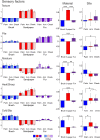Quantifying the sensory and emotional perception of touch: differences between glabrous and hairy skin
- PMID: 24574985
- PMCID: PMC3920190
- DOI: 10.3389/fnbeh.2014.00034
Quantifying the sensory and emotional perception of touch: differences between glabrous and hairy skin
Abstract
The perception of touch is complex and there has been a lack of ways to describe the full tactile experience quantitatively. Guest et al. (2011) developed a Touch Perception Task (TPT) in order to capture such experiences, and here we used the TPT to examine differences in sensory and emotional aspects of touch at different skin sites. We compared touch on three skin sites: the hairy arm and cheek, and the glabrous palm. The hairy skin contains C-tactile (CT) afferents, which play a role in affective touch, whereas glabrous skin does not contain CT afferents and is involved in more discriminative touch. In healthy volunteers, three different materials (soft brush, sandpaper, fur) were stroked across these skin sites during self-touch or experimenter-applied touch. After each stimulus, participants rated the tactile experience using descriptors in the TPT. Sensory and emotional descriptors were analyzed using factor analyses. Five sensory factors were found: Texture, Pile, Moisture, Heat/Sharp and Cold/Slip, and three emotional factors: Positive Affect, Arousal, and Negative Affect. Significant differences were found in the use of descriptors in touch to hairy vs. glabrous skin: this was most evident in touch on forearm skin, which produced higher emotional content. The touch from another was also judged as more emotionally positive then self-touch, and participants readily discriminated between the materials on all factors. The TPT successfully probed sensory and emotional percepts of the touch experience, which aided in identifying skin where emotional touch was more pertinent. It also highlights the potentially important role for CTs in the affective processing of inter-personal touch, in combination with higher-order influences, such as through cultural belonging and previous experiences.
Keywords: affective touch; c-tactile; discriminative touch; pleasant; psychophysics; somatosensory.
Figures


References
LinkOut - more resources
Full Text Sources
Other Literature Sources
Research Materials

